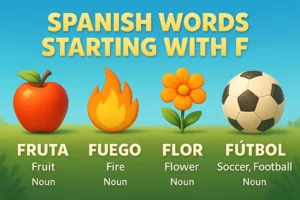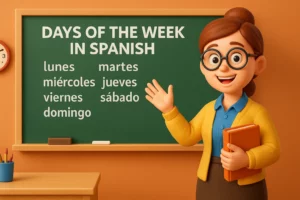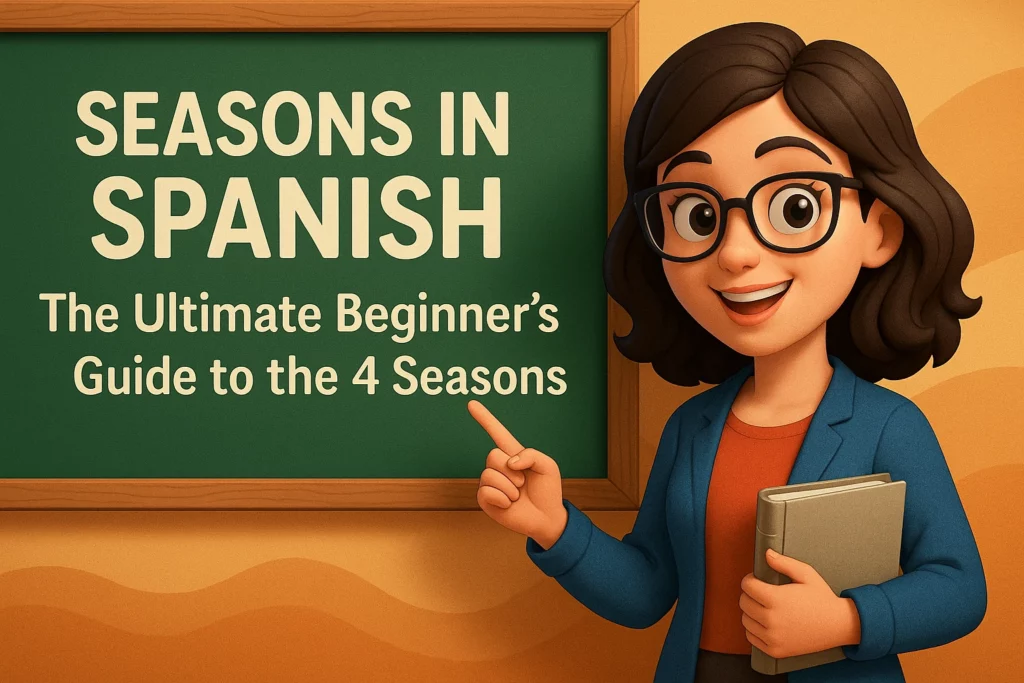
Hola, amigos! (Hello, friends!) Have you ever looked outside your window and thought, “Wow, it’s a beautiful day in spring!” or “I love the colors of fall.” Now imagine being able to say that, in Spanish.
Learning the seasons in Spanish is one of the easiest and most enjoyable parts of language learning. Why? Because you already know the seasons in English, and now, you’re just going to learn how to say them in another beautiful language Spanish!
Whether you’re a student just starting out, a parent helping your child, a traveler heading to a Spanish-speaking country, or simply someone who loves learning, this guide is written for you.
In the next few parts, I’ll walk with you, like a friendly teacher, and show you exactly:
- How to say the 4 seasons in Spanish
- What are the seasons in Spanish with their pronunciation
- How to use them in real-life conversations
- Fun cultural facts you didn’t know about seasons in Latin countries
- A quick practice section so you never forget them!
So get ready to enjoy learning, because just like the weather, this blog is about to brighten your day!
Let’s begin.
The Four Seasons in Spanish – With Meanings and Pronunciation
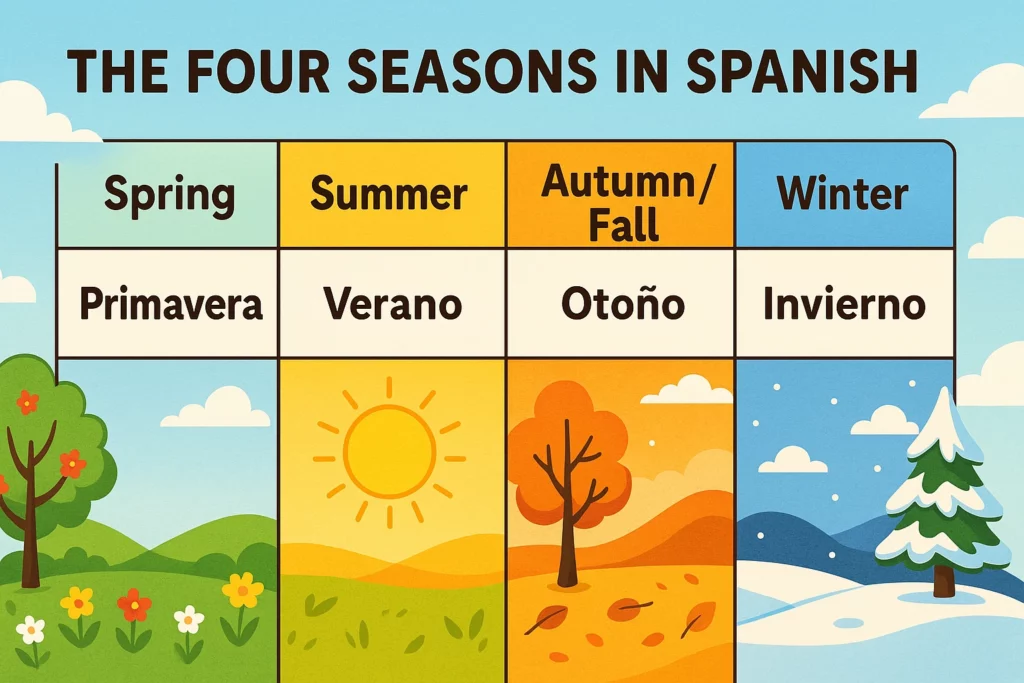
Just like in English, there are four seasons in Spanish, and they’re just as beautiful to say as they are to experience. Whether it’s the warmth of summer or the peaceful chill of winter, knowing these words in Spanish will help you express what you see and feel, no matter the time of year.
Below is a simple and clear table showing you the seasons in Spanish, along with their English meanings and easy pronunciation guides.
The 4 Seasons in Spanish
| English | Spanish | Pronunciation |
| Spring | Primavera | pree-mah-VEH-rah |
| Summer | Verano | beh-RAH-no |
| Autumn / Fall | Otoño | oh-TOH-nyo |
| Winter | Invierno | een-VYEHR-no |
A Quick Look at Each Season
- Primavera (Spring) – A season of flowers, freshness, and new beginnings.
- Verano (Summer) – Hot weather, beach time, and vacations.
- Otoño (Autumn/Fall) – Falling leaves, cozy weather, and rich colors.
- Invierno (Winter) – Cold days, snow (in some countries), and celebrations like Navidad (Christmas).
These are the four seasons in Spanish, and they are the same across almost all Spanish-speaking countries — from Spain to Mexico to Argentina.
Tip to Remember Them Faster
Link the first letter to the season:
- Primavera → P for petals (flowers)
- Verano → V for vacation
- Otoño → O for orange leaves
- Invierno → I for ice
Learning can be fun when you use memory tricks!
How to Use the Seasons in Spanish? Simple Sentences for Real Life
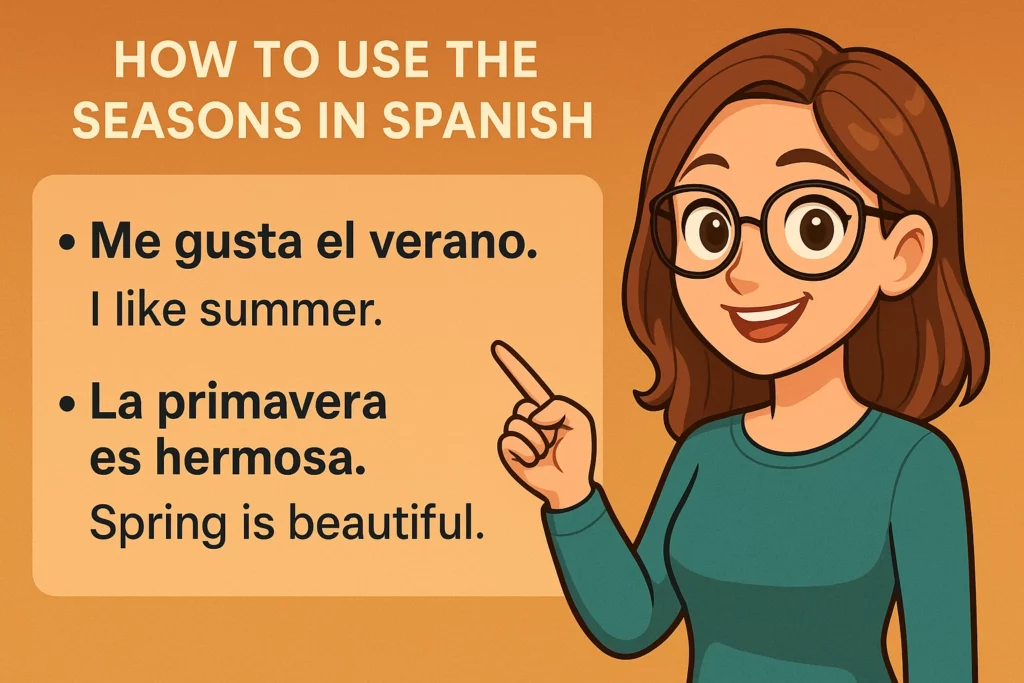
Now that you know the four seasons in Spanish, it’s time to start using them in real sentences — just like native speakers do! This part will show you easy sentence examples for everyday situations, whether you’re talking about the weather, your favorite time of year, or what you love doing in each season.
By the end of this section, you’ll not only recognize the words, you’ll be speaking in full Spanish sentences with ease and confidence.
Suggestion: Celebrate In Spanish With These Fun Birthday Greetings.
Useful Spanish Sentences with Seasons
| Spanish Sentence | English Translation |
| Me gusta el verano. | I like summer. |
| La primavera es hermosa. | Spring is beautiful. |
| El otoño tiene muchas hojas de colores. | Autumn has many colorful leaves. |
| En invierno hace frío. | It’s cold in winter. |
| Mi estación favorita es la primavera. | My favorite season is spring. |
| ¿Cuál es tu estación favorita? | What is your favorite season? |
| En verano, vamos a la playa. | In summer, we go to the beach. |
| En invierno, tomo chocolate caliente. | In winter, I drink hot chocolate. |
Conversation Practice Example
- A: ¿Cuál es tu estación favorita? (What is your favorite season?)
- B: Me gusta el otoño porque hace fresco. (I like autumn because it’s cool.)
Try reading that out loud — you’re already having a Spanish conversation!
Bonus Vocabulary:
- Estación = Season
- Tiempo = Weather
- Hace calor = It’s hot
- Hace frío = It’s cold
- Llueve = It’s raining
- Nieva = It’s snowing
These are great phrases to combine with seasons when talking about the weather.
Fun Facts and Cultural Notes About Seasons in Spanish-Speaking Countries
Learning the seasons in Spanish is not just about vocabulary—it’s also about understanding how seasons are celebrated, felt, and lived differently in Spanish-speaking cultures around the world. From summer festivals in Spain to winter holidays in Argentina, the experience of seasons can vary a lot depending on the country.
Let’s explore some fun facts, real differences, and even seasonal traditions across the Spanish-speaking world.
Seasons Happen in Reverse in the Southern Hemisphere
In countries like Argentina, Chile, and Peru, the seasons are the opposite of what we experience in the Northern Hemisphere. For example:
| Country | Month | Season |
| Argentina | December | Summer |
| Mexico | December | Winter |
| Spain | July | Summer |
| Chile | July | Winter |
So when it’s summer in the USA and Spain, it’s winter in Argentina!
Popular Seasonal Holidays in Spanish-Speaking Cultures
- Primavera (Spring):
- Las Fallas in Valencia, Spain – A colorful festival in March with fire, fireworks, and sculptures.
- Semana Santa (Holy Week) – Celebrated in many countries during late spring.
- Verano (Summer):
- San Juan Festival – In Spain and Latin America, this June festival celebrates the start of summer with bonfires and beach parties.
- Otoño (Autumn):
- Día de los Muertos (Day of the Dead) – Celebrated in Mexico and other Latin American countries in early November.
- Invierno (Winter):
- Navidad (Christmas) – One of the most beloved winter celebrations.
- In many Spanish-speaking countries, Reyes Magos (Three Kings Day) on January 6th is as big as or even bigger than Christmas!
Different Words for the Same Season?
Most Spanish-speaking countries use the same words for the four seasons, but some regional variations or pronunciation differences may exist. For example:
- In Spain, pronunciation is often more “clear” and traditional.
- In Latin America, the accent and speed of speaking might feel different—but the vocabulary remains the same.
So whether you’re in Mexico, Colombia, or Argentina, primavera still means spring.
Related: Speak Spanish With Confidence Using These Fast Learning Tips.
Quiz and Practice Section – Test What You’ve Learned
Now that you’ve learned how to say all the seasons in Spanish, use them in sentences, and even explored how they vary around the world — it’s time to test your knowledge.
Don’t worry, this is a light, fun quiz-style practice. You can use it yourself or even give it to kids if you’re a parent or teacher. Let’s reinforce what you’ve learned so it sticks in your memory forever!
Match the Season – Spanish to English
Match the Spanish word to its English meaning:
- Verano
- Primavera
- Invierno
- Otoño
- A. Winter
- B. Spring
- C. Autumn/Fall
- D. Summer
- Answers: 1-d, 2-b, 3-a, 4-c
Fill in the Blank
Complete these Spanish sentences using the correct season:
- En __________, hace mucho calor. (In _________, it’s very hot.)
- __________ es una estación muy colorida. (__________ is a very colorful season.)
- Me gusta el __________ porque hay flores. (I like __________ because there are flowers.)
- En __________, celebro la Navidad. (In __________, I celebrate Christmas.)
- Sample Answers: 1. verano, 2. otoño, 3. primavera, 4. invierno
Translate These Sentences to Spanish
- I like winter.
- My favorite season is summer.
- In spring, it rains a lot.
- Fall is beautiful.
- Sample Answers: 1. Me gusta el invierno. 2. Mi estación favorita es el verano. 3. En primavera, llueve mucho. 4. El otoño es hermoso.
Try Speaking Out Loud
Repeat these out loud 3 times:
- Primavera, verano, otoño, invierno
- Mi estación favorita es…
- Hace frío en invierno.
Practice makes permanent, and with repetition, you’ll soon say them without even thinking.
You May Also Like: Explore The Best Apps To Learn Spanish Fast And Effectively.
FAQ’s
Q1: Are the names of the seasons in Spanish the same everywhere?
Yes! Whether you’re in Spain, Mexico, Argentina, or Colombia, primavera, verano, otoño, and invierno are used. The pronunciation may vary slightly, but the words remain the same.
Q2: Is “otoño” the same as “fall” or “autumn”?
Yes. Otoño translates to both “autumn” and “fall.” In British English, we say “autumn,” and in American English, “fall” — but Spanish uses otoño for both.
Q3: How can I remember the Spanish seasons more easily?
Use mnemonic tricks (like P-V-O-I = Petals, Vacation, Orange leaves, Ice), flashcards, and repeat aloud with audio. Practice is the key!
Q4: Can I use these season names in conversations with native speakers?
Absolutely! In fact, native speakers will love that you’re trying — and these are everyday words, so you’ll sound natural and relatable.
Conclusion
Thank you for joining me on this journey through the seasons in Spanish. It means a lot that you took the time to not only read, but learn, feel curious, and grow with every word.
As someone who’s walked this path of language learning — with its little wins and big “aha” moments — I can tell you, you’re doing amazing. Every new word you learn opens the door to a new world. And I’ll be right here, guiding you step-by-step, one blog at a time.

